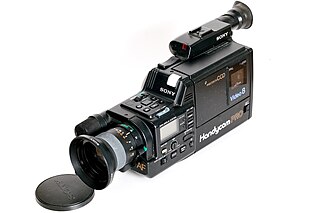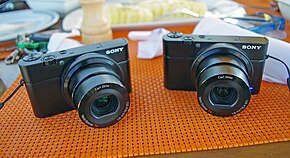The Leica Digilux 1 is a digital camera developed in partnership with Panasonic, which was released in 2002, roughly the same time as the Canon PowerShot G2 and the Nikon 2000. It is the second of Leica's digital offerings. Where the original Digilux was developed in partnership with Fuji Camera, the Digilux 1 was developed jointly with Panasonic; Leica is responsible for optics, while Panasonic designs the camera electronics. According to Leica, this allows both companies to design cameras that creates a harmonious matching of lens to sensor to produce color and contrast to Leica standards.

Cyber-shot is Sony's line of point-and-shoot digital cameras introduced in 1996. Cyber-shot model names use a DSC prefix, which is an initialism for "Digital Still Camera". Many Cyber-shot models feature Carl Zeiss trademarked lenses, while others use Sony, or Sony G lenses.

The Sony Cyber-shot DSC-R1 is a bridge digital camera announced by Sony in 2005. It featured a 10.3 megapixel APS-C CMOS sensor, a size typically used in DSLRs and rarely used in bridge cameras. This was the first time such a large sensor was incorporated into a bridge camera. Besides the APS-C sensor, the DSC-R1 also featured a 14.3–71.5 mm Carl Zeiss Vario-Sonnar T* lens, providing for an angle of view equivalent to 24–120 mm on a full frame camera.

Sony Corporation produces professional, consumer, and prosumer camcorders such as studio and broadcast, digital cinema cameras, camcorders, pan-tilt-zoom and remote cameras.
The Sony Cyber-shot DSC-TX5 is a digital still camera announced by Sony on February 18, 2010. It boasts advanced features like Backlight Correction HDR, Hand-Held Twilight aided by the Exmor R CMOS sensor, and the intelligent panorama stitching mode, called the iSweep. The camera also has a waterproof body, which also makes it dust-proof. It is also freeze-proof for up to -10 °C and shock-proof, when dropped from a height of about 1.5 meters. Sony describes it as a rugged camera.

The Sony Cyber-shot DSC-RX1 is a series of premium fixed-lens full-frame digital compact cameras made by Sony as part of its Cyber-shot line.
In Sony digital cameras, the acronym ILCE stands for "Interchangeable Lens Camera with E-mount". In August 2013, Sony announced the first model of the ILCE mirrorless camera with E-mount, electronic viewfinder, contrast-detection autofocus and Multi Interface Shoe, the ILCE-3000. In October 2013, two full-frame E-mount cameras were announced, the ILCE-7 and ILCE-7R.

The Sony Cyber-shot DSC-RX10 is a digital superzoom bridge camera made by Sony. It was announced on October 16, 2013.

The Sony Cyber-shot DSC-HX400V is a hyperzoom bridge digital camera that features:
The Sony Cyber-shot DSC-QX30 is an ultrazoom, mobile device-mountable, lens-style compact camera manufactured by Sony. Announced on September 3, 2014, the QX30 is one of Sony's "Smart Lens" cameras, alongside the QX1, QX10 and QX100, that are designed to be specifically used with a smartphone. It has a 1/2.3 inch backside-illuminated Exmor R™ CMOS sensor with 20.4 effective megapixels, sitting behind an ƒ/3.5 (wide) to ƒ/6.3 (telephoto) Sony G Lens. Its highlight feature is its 30x lossless optical zoom.
The Sony Cyber-shot DSC-RX100 IV is a digital premium compact camera announced by Sony on June 10, 2015 as the fourth entry in the Sony Cyber-shot DSC-RX100 series. It is one of a pair of cameras launched together by Sony that use their new stacked CMOS sensor. The other camera is the Sony Cyber-shot DSC-RX10 II, a model providing a larger lens and greater zoom, but less compact body.
The Sony Cyber-shot DSC-RX10 II is a DSLR-styled digital bridge camera announced by Sony on June 10, 2015. Its main improvement over its predecessor, the 2013 Sony Cyber-shot DSC-RX10, is its 2160p 4K video recording ability, as well as added high-framerate with 1080p doubled to 120fps, and high speed video at 240fps, 480fps, and 960fps.
The Sony Action Cam is a series of video-recording devices made by Sony, intended for capturing video while practicing sports.

The Sony RX is the name of a range of fixed lens compact point-and-shoot digital cameras created by Sony in 2012. All cameras are equipped with Carl Zeiss lenses.

The Sony α6300 is a mirrorless digital camera announced on 3 February 2016. The α6300 features a 24 megapixel Exmor sensor with a new 4D AF system with 425 phase detection autofocus points. The camera is powered by Sony's Bionz X image processor with an ISO range up to 51,200. Additionally, the α6300 can shoot images at up to 11 frames per second with continuous autofocus and exposure tracking. This model also introduced 4K recording for the first time in a non-full-frame Sony Camera, with it sampling to 6K before being downsampled to 4K.

The Sony Cyber-shot DSC-QX100 is a mobile device-mountable lens-style compact camera manufactured by Sony. Announced on September 3, 2014, the QX100 is one of Sony's "Smart Lens" cameras, alongside the QX1, QX10 and QX30, that are specifically designed to be used with a smartphone. Its highlight features are its 1-inch backside-illuminated Exmor R CMOS sensor taken straight from the Sony RX100 II premium compact camera, with 20.2 megapixels, ƒ/1.8 to ƒ/4.9 Carl ZEISS® Vario-Sonnar T* lens and a 3.6x (28–100 mm) optical zoom.
The Sony Cyber-shot DSC-QX10 is an ultra-compact, mobile device-mountable lens-style compact camera manufactured by Sony. Announced on September 3, 2014, the QX10 is one of Sony's "Smart Lens" cameras, alongside the QX1, QX30 and QX100 which are designed to be specifically used with a smartphone. It has a 1/2.3 inch backside-illuminated Exmor R CMOS sensor with 18.2 effective megapixels, sitting behind an ƒ/3.5 (wide) to ƒ/6.3 (telephoto) Sony G Lens. It has a 10x lossless optical zoom in a compact pancake lens-style body.

The Sony Cyber-shot DSC-WX500 is a digital selfie compact camera, which can zoom up to 30x; equivalent to 24–720 mm. Its TFT LCD screen can tilt up to 180º, it has a built-in flash and a built-in AF illuminator. It also has an Exmor R CMOS sensor and a BIONZ X image processing engine. Its customizable ring is borrowed from the Sony Cyber-shot DSC-RX100, around the front of the lens. The camera also has built-in Wi-Fi with NFC with downloadable apps, but no GPS. The WX500 features Optical Image Stabilisation.















